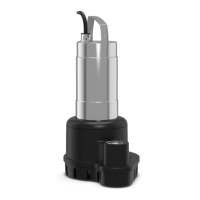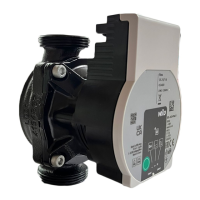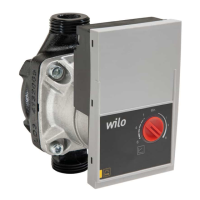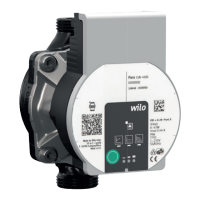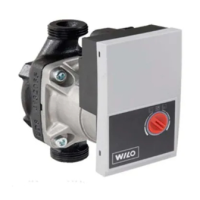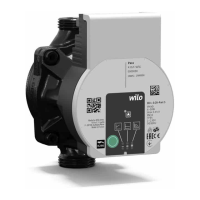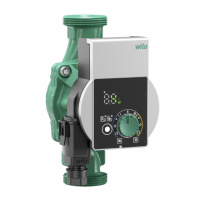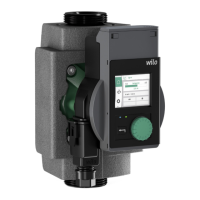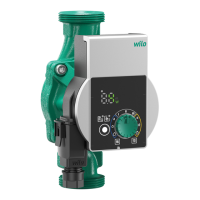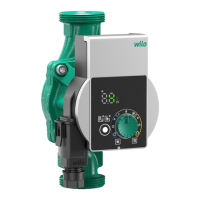Do you have a question about the Wilo Padus MINI3 5M Series and is the answer not in the manual?
Explains the purpose and importance of following the product instructions for safe handling and use.
Provides the web address for accessing the digital version of the product instructions.
Details how safety instructions are displayed, including symbols and signal words for danger and warnings.
Specifies age and understanding requirements for operating personnel, including guidelines for children and persons with limited abilities.
Warns about potential germs in stagnant water and the risk of bacterial infections, recommending disinfection.
Lists recommended personal protective equipment for transport, installation, removal, maintenance, and cleaning tasks.
Provides instructions for safe transport, handling by the handle, cleaning, and storage conditions.
Advises against installing damaged products and outlines precautions for germ formation, including air exchange and mask usage.
Details requirements for electrical connections, including qualified electricians, RCDs, and fuse protection.
Prohibits pumping flammable fluids and instructs to avoid contact with pumped fluids in accessible basins.
Advises wearing protective equipment, handling by the handle, allowing cooling, and cleaning the device after removal.
Emphasizes wearing protective equipment and following manufacturer instructions for disinfectants.
Stresses wearing protective equipment, performing work in a clean area, and using only original manufacturer parts.
Describes the operating fluid in the sealing chamber, its function, and actions for leakages and skin/eye contact.
Introduces the submersible pump for stationary and portable wet well installation in intermittent operation.
Lists key technical specifications of the pump, including power, flow, temperature, and protection class.
Explains the coding system used to identify different models of the Padus MINI3 submersible pump.
Lists the items included with the pump, such as a swing check valve and hose connection.
Describes the operational features of the pump, including thermal motor monitoring and float switch operation.
Specifies the intended applications for the pump, primarily in domestic areas for various wastewater types.
Details dangerous improper uses, such as pumping explosive fluids or specific types of wastewater, with DANGER warnings.
Outlines the two primary installation methods: stationary wet well and portable wet well.
Covers general installation advice, including site preparation, proper laying of cables, and ensuring free movement of the float switch.
Covers essential electrical connection requirements, including grounding, RCDs, and avoiding specific power sources.
Explains how to connect pumps equipped with a plug to a suitable socket.
Details the process for permanently connecting pumps without plugs to a switchgear.
Lists critical checks to perform before activating the pump, including electrical connection and fluid temperature.
Explains how the pump starts and stops based on its version, with or without a float switch, and manual control options.
Describes how to perform a test run for stationary installations, checking conditions and pump cycles.
Warns against dry running and lists checks for inlet quantity, float switch, and deposits during operation.
Provides step-by-step instructions for removing the pump from a stationary wet well installation.
Details the procedure for disconnecting and removing the pump from a portable wet well installation.
Outlines the steps for cleaning the pump after removal, including rinsing and protecting cable ends.
Explains how to clean the pump's interior, strainer, and impeller, with specific instructions for different models and warnings about sharp edges.
Specifies the capacity and recommended oil change interval for the operating fluid, listing approved oil types.
Provides a detailed, step-by-step guide for changing the oil in the sealing chamber, including safety precautions.
Recommends professional checks by customer service after a specified operating hour interval for general overhaul.
Advises on the proper disposal of electrical and electronic products, emphasizing designated collection points and local regulations.
Warns about the environmental and health risks of improper oil disposal and directs users to certified collection points.
Explains the purpose and importance of following the product instructions for safe handling and use.
Provides the web address for accessing the digital version of the product instructions.
Details how safety instructions are displayed, including symbols and signal words for danger and warnings.
Specifies age and understanding requirements for operating personnel, including guidelines for children and persons with limited abilities.
Warns about potential germs in stagnant water and the risk of bacterial infections, recommending disinfection.
Lists recommended personal protective equipment for transport, installation, removal, maintenance, and cleaning tasks.
Provides instructions for safe transport, handling by the handle, cleaning, and storage conditions.
Advises against installing damaged products and outlines precautions for germ formation, including air exchange and mask usage.
Details requirements for electrical connections, including qualified electricians, RCDs, and fuse protection.
Prohibits pumping flammable fluids and instructs to avoid contact with pumped fluids in accessible basins.
Advises wearing protective equipment, handling by the handle, allowing cooling, and cleaning the device after removal.
Emphasizes wearing protective equipment and following manufacturer instructions for disinfectants.
Stresses wearing protective equipment, performing work in a clean area, and using only original manufacturer parts.
Describes the operating fluid in the sealing chamber, its function, and actions for leakages and skin/eye contact.
Introduces the submersible pump for stationary and portable wet well installation in intermittent operation.
Lists key technical specifications of the pump, including power, flow, temperature, and protection class.
Explains the coding system used to identify different models of the Padus MINI3 submersible pump.
Lists the items included with the pump, such as a swing check valve and hose connection.
Describes the operational features of the pump, including thermal motor monitoring and float switch operation.
Specifies the intended applications for the pump, primarily in domestic areas for various wastewater types.
Details dangerous improper uses, such as pumping explosive fluids or specific types of wastewater, with DANGER warnings.
Outlines the two primary installation methods: stationary wet well and portable wet well.
Covers general installation advice, including site preparation, proper laying of cables, and ensuring free movement of the float switch.
Covers essential electrical connection requirements, including grounding, RCDs, and avoiding specific power sources.
Explains how to connect pumps equipped with a plug to a suitable socket.
Details the process for permanently connecting pumps without plugs to a switchgear.
Lists critical checks to perform before activating the pump, including electrical connection and fluid temperature.
Explains how the pump starts and stops based on its version, with or without a float switch, and manual control options.
Describes how to perform a test run for stationary installations, checking conditions and pump cycles.
Warns against dry running and lists checks for inlet quantity, float switch, and deposits during operation.
Provides step-by-step instructions for removing the pump from a stationary wet well installation.
Details the procedure for disconnecting and removing the pump from a portable wet well installation.
Outlines the steps for cleaning the pump after removal, including rinsing and protecting cable ends.
Explains how to clean the pump's interior, strainer, and impeller, with specific instructions for different models and warnings about sharp edges.
Specifies the capacity and recommended oil change interval for the operating fluid, listing approved oil types.
Provides a detailed, step-by-step guide for changing the oil in the sealing chamber, including safety precautions.
Recommends professional checks by customer service after a specified operating hour interval for general overhaul.
Advises on the proper disposal of electrical and electronic products, emphasizing designated collection points and local regulations.
Warns about the environmental and health risks of improper oil disposal and directs users to certified collection points.
The Wilo-Padus MINI3 is a submersible drainage pump designed for both stationary and portable wet well installations, operating in intermittent mode. It is engineered for pumping in domestic areas, specifically for sewage not containing faeces, wastewater with small amounts of sand and gravel, rainwater, and drainage water. The pump is suitable for fluid temperatures between 3 °C and 40 °C (37 °F and 104 °F).
The Wilo-Padus MINI3 is equipped with either a vortex impeller (V-type) or a semi-open multi-channel impeller (M-type), both designed for efficient fluid handling. The hydraulics housing and impeller are made of plastic. The pump features a surface-cooled 1~ motor (single-phase) or 3~ motor (three-phase) with integrated operating capacitors and self-switching thermal motor monitoring. This thermal monitoring system automatically deactivates the pump if the motor becomes too hot and reactivates it once it has cooled down, ensuring protection against overheating.
The motor housing is made of stainless steel. A key feature is the oil-filled sealing chamber with a double sealing system: a rotary shaft seal on the motor side and a mechanical seal on the pump side. This design enhances durability and prevents fluid ingress into the motor.
Depending on the model, the pump may come with a detachable connection cable with a fitted plug (CEE 7/7) or a bare cable end for fixed connection to on-site controls. Some models (e.g., Padus MINI3-...-A) are equipped with a float switch, which automatically turns the pump on and off based on the fluid level. The upper floater triggers the pump to turn on, while the lower floater turns it off. Models without a float switch and plug are designed for fixed connections to external controls.
The pump's design allows for easy installation, with options for vertical stationary or portable wet well setups. It includes a handle for convenient transport and positioning.
The Wilo-Padus MINI3 is intended for use in domestic environments, specifically for applications involving:
The pump is not designed for pumping highly flammable and explosive fluids (such as gasoline or kerosene), untreated sewage, sewage containing faeces, drinking water, fluids with hard components (stones, wood, metal), fluids with high quantities of abrasive contents (sand, gravel), viscous fluids (oil, grease), or seawater. Use in potentially explosive atmospheres is strictly prohibited.
For stationary wet well installation, the pump is placed directly onto the pressure pipe, which must be self-supporting. The connection to the pressure pipe should be stress-free and sealed with Teflon tape. It is crucial to install appropriate valves (gate valve, non-return valve) and ensure the discharge pipe is frost-proof. Air pockets in the pump and discharge pipe should be avoided to prevent delivery problems, potentially requiring ventilation systems like an air vent valve. For portable wet well installation, the pump can be placed at any suitable location, secured against falling over, with the pressure hose attached and routed properly.
When operating, it's important to ensure the float switch can move freely (if present) and that the inlet quantity does not exceed the pump's delivery rate to prevent overflow. The pump should never be run dry, as this can damage the seal.
Regular maintenance is crucial for the longevity and efficient operation of the Wilo-Padus MINI3. All maintenance tasks should be performed in a clean, dry, and well-lit environment, using only original manufacturer parts.
Cleaning:
Operating Fluid (Oil):
General Overhaul:
Storage:
Safety Precautions:
| Model | Padus MINI3 5M Series |
|---|---|
| Protection class | IP68 |
| Frequency | 50 Hz |
| Max Liquid Temperature | 40°C |
| Type | Submersible pump |
| Power Supply | 230V, 50Hz |
| Fluid temperature | 3°C to 40°C |
| Connection | G 1" |
